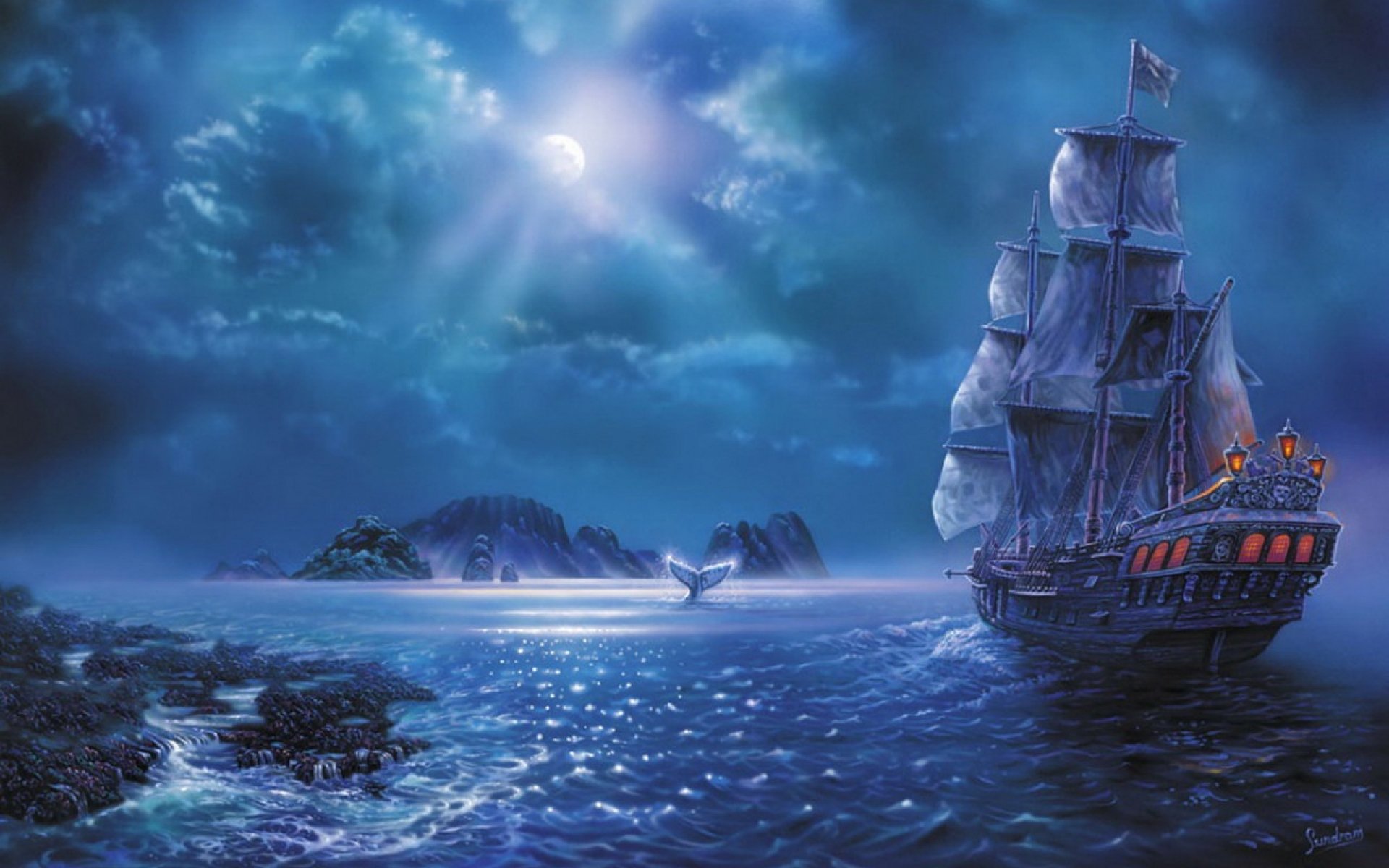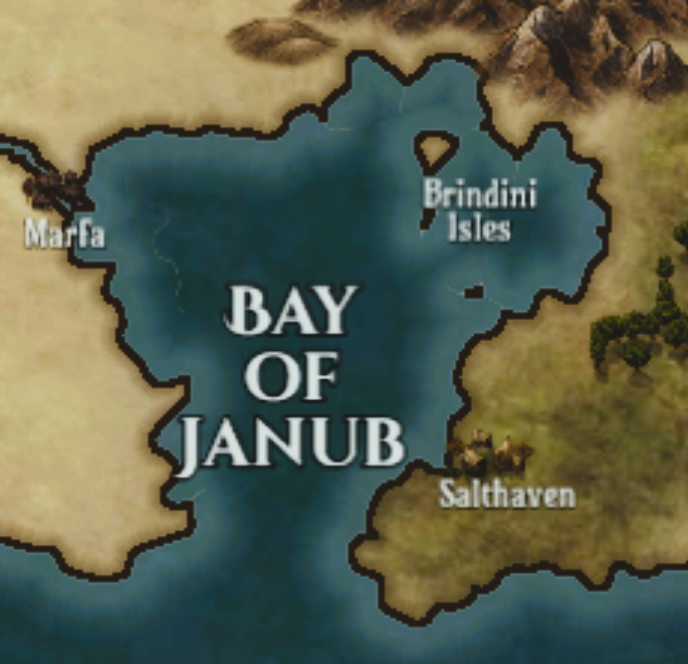The Bay of Janub
Geography
The Bay of Janub is large body of water bounded by the lands of Aurulant in the west and Veltingard in the east. On the northern coastline are the Brigas en'Galar, or the Galar Mountains, the Elven word for sorrow. The cliffs of the mountain range border the Bay, leaving no place for ships to make land there.
Much of the western coastline is sandy beaches, fading into grassy high desert and savannah. The eastern coastline, by contrast, is rocky and marshy, leading into swampy rainforests and jungles.
There are two main coastal settlements within the Bay of Janub -
Within the Bay of Janub are three small islands known as the Brindini Isles, named for the first explorer to set foot on them. Northernmost and largest of the Brindini Isles is Zorlu, which while it pays a tribute of 100 kopins to Aurulant every year, claims they are independent. Zorlu has three small villages and its main town named Leuwton, which acts as its capitol. Zorlu's Lord Governor, who holds their office for ten years, claims rulership over all three Brindini Isles. Just south of Zorlu is Hark Island, which has no permanent settlements on it, but large herds of sheep and cattle. Hark Island has a rocky coastline, which then rises approximately twenty feet from sea level to become flat. The soil is poor for growing any sort of vegetables or crops, or even trees. The natural grasses that grow on Hark Island are only fit for grazing livestock. The combination of no arable land, a flat island that is always at risk of flooding, and the lack of any barrier to winds makes Hark Island inhospitable. The Zorlusian shepherds and cattleherds that work here are well paid, and only stay for a few weeks at a time. Southernmost of the Brindini Islands is Minik, located just off the headlands of Veltingard. Minik began life as a monastery for ascetic priests of a long-forgotten god during the Second Age, but over time it became a walled fortress and finally, a walled town. The Town of Minik encompasses the entirety of the island. While fishing is the main occupation of much of the population, Minik also trains and houses a marine unit of soldiers known as the Sea Pikes, named both for the vicious saltwater fish and the long-shafted weapons they wield, a polearm known as a hooked pike.
- the port city of Marfa, which lies at the mouth of the Alhaya River. Marfa is part of the Aurulant Empire, and is presently ruled by the Satrap of Marfa Akbar abn Akbar, a Human male member of one of the Golden Houses. Marfa is a significant trading hub.
- the town of Salthaven, which lies just north of Crannish Point in Veltingard. While nominally under the authority of Veltingard, Salthaven leans towards independence. The town is known for their shipbuilding expertise.
Within the Bay of Janub are three small islands known as the Brindini Isles, named for the first explorer to set foot on them. Northernmost and largest of the Brindini Isles is Zorlu, which while it pays a tribute of 100 kopins to Aurulant every year, claims they are independent. Zorlu has three small villages and its main town named Leuwton, which acts as its capitol. Zorlu's Lord Governor, who holds their office for ten years, claims rulership over all three Brindini Isles. Just south of Zorlu is Hark Island, which has no permanent settlements on it, but large herds of sheep and cattle. Hark Island has a rocky coastline, which then rises approximately twenty feet from sea level to become flat. The soil is poor for growing any sort of vegetables or crops, or even trees. The natural grasses that grow on Hark Island are only fit for grazing livestock. The combination of no arable land, a flat island that is always at risk of flooding, and the lack of any barrier to winds makes Hark Island inhospitable. The Zorlusian shepherds and cattleherds that work here are well paid, and only stay for a few weeks at a time. Southernmost of the Brindini Islands is Minik, located just off the headlands of Veltingard. Minik began life as a monastery for ascetic priests of a long-forgotten god during the Second Age, but over time it became a walled fortress and finally, a walled town. The Town of Minik encompasses the entirety of the island. While fishing is the main occupation of much of the population, Minik also trains and houses a marine unit of soldiers known as the Sea Pikes, named both for the vicious saltwater fish and the long-shafted weapons they wield, a polearm known as a hooked pike.
Ecosystem
The Bay of Janub is fairly deep, averaging 800 fathoms. Along the coastline are narrow shelves where the depth of the Bay can be as little 8 to 10 fathoms, but such shallows are rare. This makes smuggling throughout the Bay a dangerous proposition; without secure locations to come ashore, smugglers have to either risk their ships or try and sneak contraband into established ports of call.
The deep water of the Bay permits all sorts of marine life to call the Bay of Janub their home. Sharks, orcas, even kraken have been spotted within the Bay.
Climate
The climate of the Bay of Janub is tropical. Warm, moist trade winds blow consistently from the east, creating both rain forest in the eastern half of the Bay and semi arid climates in the western half. The mountains along the northern coastline of the bay as both a barrier and a sponge, blocking much of the rain from reaching the Aurulant coast.
While the bay generally is sunny much of the year, the wet season from Gittinculd through Windenrane sees more frequent cloud cover (both broken and overcast), while the dry season from Buddin through Havestett is more often clear to mostly sunny. The air temperature is hot much of the year, not varying much between seasons. Protected by the eastern and western peninsulas, violent storms and hurricanes are rare in the Bay of Janub, but can occur.
Type
Bay
Owning Organization
Contested By



Comments